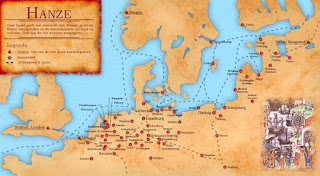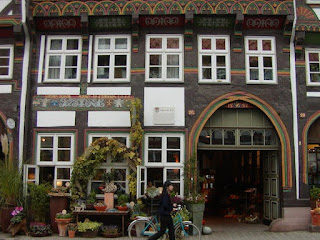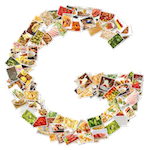 |
| Street with timbered buildings in Einbeck |
History of Beer Making in Einbeck
The history of beer making in Einbeck goes back to the 14th century. Beer trade was significant for the city of Einbeck which had over 700 master brewers and every citizen had the right to brew beer. The city council purchased the overproduction and handled the marketing and sales of beer in the whole of Germany and abroad. |
| Einbeck market square |
 |
| Map of the Hanseatic League showing main Hanseatic cities and trade routes |
This famous beer from Einbeck was called 'Ainpöckische Bier' and it was brewed as a dark, malty, lightly hopped ale with strong alcohol content to preserve the beer for its long journeys.
 |
| Einbeck timbered house |
The Einbecker brewery in Einbeck founded in the middle of the 14th century is one of the oldest still operating breweries in the world.
How Bock Got Its Name and Different Styles
Due the growing popularity and shipments of the strong Einbecker beer, in 1612, Munich lured a Einbeck master brewer to produce the beer in Bavaria.In Bavaria, the Einbecker beer was adapted to the lager, to suit the Bavarian style of making beer in the cooler months of autumn and winter with bottom-fermented yeast.
 |
| Einbecker Winterbock in traditional 'Einbecker' bottle by Herbertkarl |
Bock beers have a long history of being brewed and consumed by Bavarian monks as a source of nutrition during times of fasting. The beers brewed by the monks were strong with a lot of malt, while those produced by the Bavarian brewers for consumption at spring festivals were paler with more hops. It was in Bavaria where the different styles of Bock were developed.
The Family of Bock Beers
There are different styles of Bock beer with differences in strength and the amount of hops and malts used for brewing.Traditional Bock
- Traditional bock is full-bodied, relatively strong, lightly hopped lager with malty and toasty aromas and notes of caramel.
- The color can range from light copper to brown, with an off-white foam on the top of the beer.
- The beer is characterized by a subtle hint of hops in accordance with the original recipe.
Doppelbock
- Doppelbock is a stronger version of the Traditional bock, that was first brewed in a convent in Munich by the monks during the Lenten fast.
- The color can range from dark gold for paler version to dark brown with ruby highlights for darker version.
- The beer is characterized by a subtle hint of hops with rich and malty flavors.
Maibock
- Also known as helles bock, it is more refreshing with moderate to strong malt aroma, and hop character generally more apparent than in other bock beers.
- The color can range from deep gold to light amber with a large, creamy foam on the top of the beer.
- It is a fairly recent development compared to other styles of bock beers, and is frequently associated with springtime and the month of May.
Eisbock
- Eisbock is a traditional specialty of the Kulmbach district of Bavaria brewed by freezing a doppelbock and removing the ice to concentrate the flavor and alcohol content.
- The color can range from deep copper to dark brown in color, often with ruby highlights.
- The flavor is rich and sweet, sometimes with hints of chocolate, always balanced by a significant alcohol presence.
References
The Oxford Companion to Beer by Garrett OliverArticle Category: Drinks History




No comments